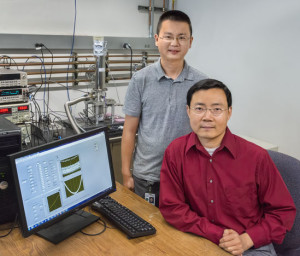Oct 20 2015
Researchers from the U.S. Department of Energy’s Lawrence Berkeley National Laboratory have experimentally proved that single-crystal black phosphorous nanoribbons exhibit anisotropic in-plane thermal conductivity strongly, up to a factor of two, along their armchair and zigzag directions.
 Junqiao Wu (seated) and Yang Fan showed that the flow of heat in black phosphorous nanoribbons can be very different along different directions in the crystal plane. (Photo by Roy Kaltschmidt)
Junqiao Wu (seated) and Yang Fan showed that the flow of heat in black phosphorous nanoribbons can be very different along different directions in the crystal plane. (Photo by Roy Kaltschmidt)
This experimental discovery regarding black phosphorus nanoribbons is likely to pave the way for the future application of this very unique material in electronic, thermoelectric and optoelectronic gadgets.
“Imagine the lattice of black phosphorous as a two-dimensional network of balls connected with springs, in which the network is softer along one direction of the plane than another,” says Junqiao Wu, a physicist who holds joint appointments with the University of California (UC) Berkeley’s Department of Materials Science and Engineering and Berkeley Lab’s Materials Sciences Division. “Our study shows that in a similar manner heat flow in the black phosphorous nanoribbons can be very different along different directions in the plane. This thermal conductivity anisotropy has been predicted recently for 2D black phosphorous crystals by theorists but never before observed.”
The research work has been described in a paper appeared in the Nature Communications journal under the title, “Anisotropic in-plane thermal conductivity of black phosphorus nanoribbons at temperatures higher than 100K.” Lead authors on the paper are Sangwook Lee and Fan Yang, and corresponding author is Wu.
Black phosphorous is so named due to its characteristic color. It is a naturally semiconducting material possessing an energy bandgap, which facilitates switching on and off its electrical conductance. Theoretically, black phosphorous exhibits opposite anisotropy in electrical and thermal conductivities when compared to graphene, meaning that the flow of heat is easier along a direction wherein electricity struggles to flow. This type of anisotropy would be very useful in the development of energy-efficient thermoelectric devices and transistors. However, verification via experiments proved to be an uphill task due to sample preparation and measurement needs.
“We fabricated black phosphorous nanoribbons in a top-down approach using lithography, then utilized suspended micro-pad devices to thermally isolate the nanoribbons from the environment so that tiny temperature gradient and thermal conduction along a single nanoribbon could be accurately determined,” Wu says. “We also went the extra mile to engineer the interface between the nanoribbon and the contact electrodes to ensure negligible thermal and electrical contact resistances, which is essential for this type of experiment.”
The research was conducted in the premises of the Molecular Foundry, a DOE Office Science User Facility hosted by Berkeley Lab. The outcome of these experiments showed that thermal conductivity of black phosphorous demonstrated high directional anisotropy at temperatures beyond 100K.
Orientation-dependent phonon dispersion contributed significantly to this anisotropy, which is also influenced by orientation- dependent phonon-phonon scattering rate to some extent. Further testing at 300K showed that thermal conductivity reduced as the nanoribbon’s thickness shrank from about 300nm to nearly 50nm. There is no change in the ratio of anisotropy within this thickness range, remaining at a factor of two.
“The anisotropy we discovered in the thermal conductivity of black phosphorous nanoribbons indicates that when these layered materials are patterned into different shapes for microelectronic and optoelectronic devices, the lattice orientation of the patterns should be considered,” Wu says. “This anisotropy can be especially advantageous if heat generation and dissipation play a role in the device operation. For example, these orientation-dependent thermal conductivities give us opportunities to design microelectronic devices with different lattice orientations for cooling and operating microchips. We could use efficient thermal management to reduce chip temperature and enhance chip performance.”
Going forward, Wu and fellow researchers will make use of their experimental study to analyze the various scenarios, such as phase-transitions, hetero-interfaces, and domain boundaries, which may affect thermal conductivity in black phosphorous nanoribbons. They will also be focusing on the effects of a mixture of physical conditions, such as pressure and stress.
Besides Wu, Lee and Yang, the other co-authors of the paper are Joonki Suh, Sijie Yang, Yeonbae Lee, Guo Li, Hwan Sung Choe, Aslihan Suslu, Yabin Chen, Changhyun Ko, Joonsuk Park, Kai Liu, Jingbo Li, Kedar Hippalgaonkar, Jeffrey Urban and Sefaattin Tongay.
The Department of Energy Office of Science supported this research.